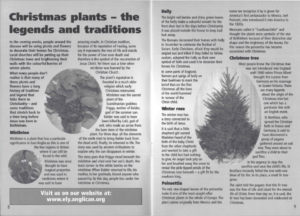Christmas plants – the legends and traditions
This article written by me appeared in the Ely Ensign in December 2006 on page 8.
In the coming weeks, people around the diocese will be using plants and flowers to decorate their homes for Christmas. Local churches will be putting up their Christmas trees and brightening their walls with the colourful berries of the winter plants.
What many people don’t realise is that many of these plants and flowers have a long history of tradition and legend that links them to Christianity – and some traditions that stretch back to a time long before Jesus was born in Bethlehem.

Mistletoe
Mistletoe is a plant that has a particular significance in East Anglia as this is one of the few regions in Britain where it can still be found in the wild.
Mistletoe was once thought to have magical properties and was used in medicines where it was said to have amazing results. In Christian tradition, because of its reputation of healing, some say it represents the tree of life and stands for the power of love over death and therefore is the symbol of the resurrection of Jesus Christ. Yet there was a time when mistletoe was banned by the Christian Church.
The plant’s reputation is founded in a much older religion which early Christians mistrusted. Mistletoe was the sacred plant of the Scandinavian goddess, Frigga, mother of Balder, the god of the summer sun.
Balder was said to have been killed by Loki, god of evil, who made an arrow from the bare stem of the mistletoe plant.
For three days all the elements of the earth tried to bring Balder back from the dead until, finally, he returned to life. The story was used by ancient civilisations to explain why the sun disappears in winter.
The story goes that Figga stood beneath the mistletoe and cried over her son’s death. Her tears turned to the white berries on the mistletoe. When Balder returned to life, his mother, in her gratitude, kissed anyone who passed by. To this day, people kiss under the mistletoe at Christmas.
Holly
The bright red berries and shiny green leaves of he holly make a colourful wreath for the front door but in the days before Christianity it was placed outside the house to keep bad luck away.
The Romans decorated their homes with holly in December to celebrate the festival of Saturn. Early Christians, afraid they would be singled out and killed if they failed to follow custom, adopted the holly as their own symbol of faith and used it to decorate their homes for Christmas.
In some parts of England, farmers put sprigs of holly on their beehives to mark the belief that on the first Christmas all the bees of the world hummed in honour of the Christ-child.
Winter Rose
The winter rose has a story connected to the birth of Jesus.
It is said that a little shepherd girl named Madelon heard of the birth of the baby Christ from the other shepherds and wanted to take a gift to the child but had nothing to give. An angel took pity on her and brushed away the snow to reveal the pink-tipped petals of the Christmas rose beneath – a gift fit for the newborn king.
Poinsettia
The red, star-shaped leaves of the poinsettia make it one of the most sought-after Christmas plants in the whole of Europe. The plant comes originally from Mexico and the name we recognise it by is given for America’s first ambassador to Mexico, Joel Poinsett, who introduced it into America in the 1820s.
Mexicans called it “Cuetlaxochitle” and thought the plants were symbolic of the star of Bethlehem because of their distinctive star shape and the brightness of the leaves. For this reason the poinsettia has become associated with Christmas.
Christmas Tree
Most people know the Christmas tree was not introduced into England until 1840 when Prince Albert brought the custom from Germany on his marriage to Queen Victoria. There are many legends about the origin of the Christmas tree but one which has a particular link with an English monk.
St Boniface, who spread the Christian faith in France and Germany, is said to have discovered a group of pagans gathered around an oak tree. They were about to sacrifice a child to their god Thor.
In his urgency to stop the sacrifice and save the child’s life, St Boniface instantly felled the tree with one blow of his fist. In its place, a small fir tree grew.
The saint told the pagans that this fir tree was the Tree of Life and stood for the eternal life of Christ. From that day on, it is said, the fir tree has been decorated and celebrated at Christmas.

